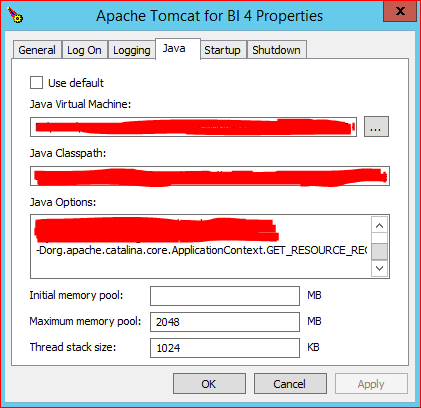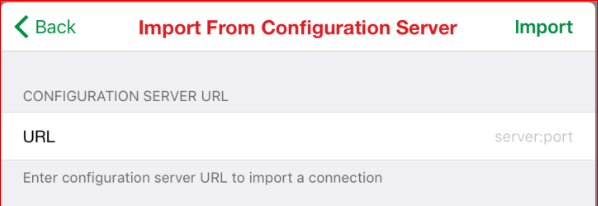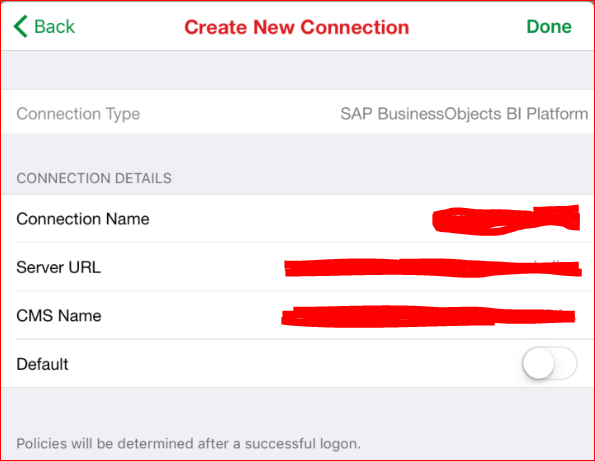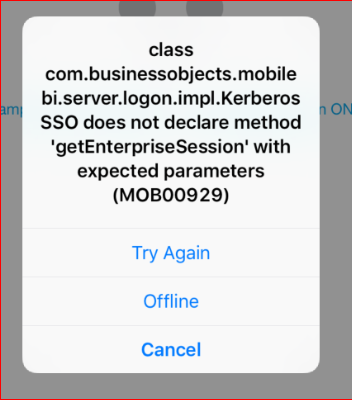
- SAP Community
- Products and Technology
- Technology
- Technology Blogs by Members
- SAP Mobile BI WinAD SSO - Kerberos
- Subscribe to RSS Feed
- Mark as New
- Mark as Read
- Bookmark
- Subscribe
- Printer Friendly Page
- Report Inappropriate Content
This blog will solely look at the integration of Mobile BI with a Kerberos SSO setup on a BI 4.2 SP02 environment.
Prerequisites:
- SAP BI 4.2 SP2 landscape
- SSO already setup
- MDM profile management in place
- If you need to implement the fix for Tomcat (check 1.4 below) make sure to stop/start the Tomcat server. The rest of MoBI can be stopped/started individually from Tomcat.
1 web.xml
You can find the web.xml file via the following path (depending on your deployment of your installation):
<Installation Folder>\SAP BusinessObjects\tomcat\webapps\MobileBIService\WEB-INF\web.xml
Ensuring that the following settings are marked as active in this file.
<filter>
<filter-name>KerberosFilter</filter-name>
<filter-class>com.businessobjects.mobilebi.server.filters.KerberosFilter</filter-class>
<init-param>
<param-name>sso.enabled</param-name>
<param-value>true</param-value>
</init-param>
<init-param>
<param-name>siteminder.enabled</param-name>
<param-value>false</param-value>
</init-param>
<init-param>
<param-name>vintela.enabled</param-name>
<param-value>true</param-value>
</init-param>
<init-param>
<param-name>idm.realm</param-name>
<param-value><YOUR.FULL.DOMAINNAME></param-value>
</init-param>
<init-param>
<param-name>idm.princ</param-name>
<param-value><BICMS/YOUR_BICMS_SPN_SETUP></param-value>
</init-param>
<init-param>
<param-name>idm.allowUnsecured</param-name>
<param-value>true</param-value>
</init-param>
<init-param>
<param-name>idm.allowNTLM</param-name>
<param-value>false</param-value>
</init-param>
<init-param>
<param-name>idm.logger.name</param-name>
<param-value>simple</param-value>
</init-param>
<init-param>
<param-name>idm.logger.props</param-name>
<param-value>error-log.properties</param-value>
</init-param>
<init-param>
<param-name>idm.keytab</param-name>
<param-value><THE_PATH_PLUS_FILE_NAME_TO_YOUR_KTPASS></param-value>
</init-param>
</filter>
<filter-mapping>
<filter-name>KerberosFilter</filter-name>
<servlet-name>VintelaServlet</servlet-name>
<dispatcher>REQUEST</dispatcher>
<dispatcher>FORWARD</dispatcher>
<dispatcher>INCLUDE</dispatcher>
</filter-mapping>
The items that are environment specific:
<init-param>
<param-name>idm.realm</param-name>
<param-value><YOUR.FULL.DOMAINNAME></param-value>
</init-param>
Ensure for the idm.realm to set <YOUR.FULL.DOMAINNAME> to your full DN.
<init-param>
<param-name>idm.princ</param-name>
<param-value><BICMS/YOUR_BICMS_SPN_SETUP></param-value>
</init-param>
Ensure for the idm.princ to set <BICMS/YOUR_BICMS_SPN_SETUP> to the BICMS corresponding to your services accounts SPN setup as was done for the initial SSO deployment.
Additional paramaters to be added to the original file!
<init-param>
<param-name>idm.keytab</param-name>
<param-value><THE_PATH_PLUS_FILE_NAME_TO_YOUR_KTPASS></param-value>
</init-param>
The idm.keytab is currently NOT highlighted in the web.xml file and is not highlighted in the documentation! However you will need to add this for a successful deployment.
Make sure to add all 4 lines to your web.xml. Change the <THE_PATH_PLUS_FILE_NAME_TO_YOUR_KTPASS> to wherever you stored your KTPASS from your original Kerberos configuration!
e.g. C:\Windows\myenvironment.keytab
All these manual settings can be found in your original SSO deployment in the global.properties file:
<Installation Folder>\tomcat\webapps\BOE\WEB-INF\config\custom\global.properties.
1.1 authscheme.properties
Copy the authscheme.properties from the default to the custom folder via the following path (depending on your deployment of your installation):
<Installation Folder>\SAP BusinessObjects\tomcat\webapps\MobileBIService\WEB-INF\config\default
TO
<Installation Folder>\SAP BusinessObjects\tomcat\webapps\MobileBIService\WEB-INF\config\custom
# allows kerberos logon
KERBEROS=com.businessobjects.mobilebi.server.logon.impl.KerberosSSO
Ensure to activate the KERBEROS line, no further changes required rather than removing the #
1.2 sso.properties
Copy the sso.properties from the default to the custom folder via the following path (depending on your deployment of your installation):
<Installation Folder>\SAP BusinessObjects\tomcat\webapps\MobileBIService\WEB-INF\config\default
TO
<Installation Folder>\SAP BusinessObjects\tomcat\webapps\MobileBIService\WEB-INF\config\custom
# You can configure mobile server to connect multiple CMS, specify default CMS id here
default.cms.identifier=1
# You can specify IP Address/Qualified Name/Alias for your CMS here
1.aliases=<CMS_NAME:PORT>
# You can specify the Authentication type here. secLDAP, secWinAD, secEnterprise
1.authentication.type=secWinAD
# Specify the default authentication scheme here. USERPASS, BASIC, BOETOKEN, COOKIE, TRUST
1.authentication.scheme=KERBEROS
There are four lines that need to be activated in this file with the identifier set in the first example:
# You can configure mobile server to connect multiple CMS, specify default CMS id here
default.cms.identifier=1
First one is to identify your default CMS, which is not relevant if you are running a single box as then it will always be 1. This value is then used to activate the following lines as well.
# You can specify IP Address/Qualified Name/Alias for your CMS here
1.aliases=<CMS_NAME:PORT>
Make sure to specify your full CMS name including the port e.g MyCMS:6400.
In case you make use of clustering with a supporting clustering file, just fill in this name only e.g. @BI-DEV
IMPORTANT NOTE
This name needs to be identical to the name specified in the server.properties which will be mentioned below.
# You can specify the Authentication type here. secLDAP, secWinAD, secEnterprise
1.authentication.type=secWinAD
Specify the authentication type here to secWinAD.
# Specify the default authentication scheme here. USERPASS, BASIC, BOETOKEN, COOKIE, TRUST
1.authentication.scheme=KERBEROS
Specify the authentication scheme to KERBEROS (mind you to use capital letters!)
1.3 server.properties
Copy the server.properties from the default to the custom folder via the following path (depending on your deployment of your installation):
<Installation Folder>\SAP BusinessObjects\tomcat\webapps\MOBIServer\WEB-INF\config\default
TO
<Installation Folder>\SAP BusinessObjects\tomcat\webapps\MOBIServer\WEB-INF\config\custom
mobi.connections=sso
sso.DisplayName=Nick_is_AWESOME!
sso.BOBJ_MOBILE_SSO_ENABLED:true
sso.BOBJ_MOBILE_SSO_TYPE:kerberos
sso.BOBJ_MOBILE_URL=<HTTP(S)://URL_TO_BI_SERVER:PORT>
sso.BOBJ_MOBILE_CMS=<CMS_NAME:PORT>
mobi.connections=sso
Activate your mobi connection by giving it a unique name, e.g. sso.
This will then need to be used onward for this specific connection setup.
sso.DisplayName=Nick_is_AWESOME!
This can be any given name that will reflect on the MobileApp as the connection name.
sso.BOBJ_MOBILE_SSO_ENABLED:true
SSO_ENABLED needs to be set to true
sso.BOBJ_MOBILE_SSO_TYPE:kerberos
SSO_TYPE needs to be set to Kerberos (mind you that this is in small letters!)
sso.BOBJ_MOBILE_URL=<HTTP(S)://URL_TO_BI_SERVER:PORT>
Fill in the URL that specifies your BI Server e.g. HTTP(S):MyBIServer:<PORT>
sso.BOBJ_MOBILE_CMS=<CMS_NAME:PORT>
Fill in the CMS name the same way as setup in the sso.properties file, e.g. MyCMS:6400
In case you make use of clustering with a supporting clustering file, just fill in this name only e.g. @BI-DEV
1.4 Tomcat Configuration
Lastly you will need to add a line to your Tomcat configuration.
-Dorg.apache.catalina.core.ApplicationContext.GET_RESOURCE_REQUIRE_SLASH=true

Additional note!
This is only applicable if you run the SAP supplied version of Tomcat that was shipped with 4.2 (Apache Tomcat/8.0.21)
This issue is resolved in Apache Tomcat 8.0.29 onward (link)
Check your version otherwise this setting is NOT needed!
1.5 Setup connection on Mobile BI APP
Setup a new connection by calling the Import Connection option.

Now you select Configuration Server

In the URL box you log your BI Server name and port: e.g. HTTP(S):MyBIServer:<PORT>. Now select Import

Now the app will get the connection details from the server. On the connections you will see all the defined connections from the earlier set server.properties file. Select the desired connection.

You now see all the credentials as expected from the setup server.properties file. Select done.

Now the system will automatically try to establish a SSO connection to the server.
1.6 Known Errors
1.6.1 MOB00929
This message comes up when you try to make an AD SSO attempt from MobileBI towards the SAP BI backend.
Full message: classcom.businessobjects.mobile.bi.server.logon.impl.KerberosSSO does not declare method ‘getEnterpriseSession’ with expected parameters (MOB00929)
Solution:
Ensure that you set the keytab entry in the web.xml file as well as to add the additional line into the Tomcat configuration as described above.

- SAP Managed Tags:
- SAP BusinessObjects Mobile,
- Mobile
You must be a registered user to add a comment. If you've already registered, sign in. Otherwise, register and sign in.
-
"automatische backups"
1 -
"regelmäßige sicherung"
1 -
"TypeScript" "Development" "FeedBack"
1 -
505 Technology Updates 53
1 -
ABAP
14 -
ABAP API
1 -
ABAP CDS Views
2 -
ABAP CDS Views - BW Extraction
1 -
ABAP CDS Views - CDC (Change Data Capture)
1 -
ABAP class
2 -
ABAP Cloud
2 -
ABAP Development
5 -
ABAP in Eclipse
1 -
ABAP Platform Trial
1 -
ABAP Programming
2 -
abap technical
1 -
absl
1 -
access data from SAP Datasphere directly from Snowflake
1 -
Access data from SAP datasphere to Qliksense
1 -
Accrual
1 -
action
1 -
adapter modules
1 -
Addon
1 -
Adobe Document Services
1 -
ADS
1 -
ADS Config
1 -
ADS with ABAP
1 -
ADS with Java
1 -
ADT
2 -
Advance Shipping and Receiving
1 -
Advanced Event Mesh
3 -
AEM
1 -
AI
7 -
AI Launchpad
1 -
AI Projects
1 -
AIML
9 -
Alert in Sap analytical cloud
1 -
Amazon S3
1 -
Analytical Dataset
1 -
Analytical Model
1 -
Analytics
1 -
Analyze Workload Data
1 -
annotations
1 -
API
1 -
API and Integration
3 -
API Call
2 -
Application Architecture
1 -
Application Development
5 -
Application Development for SAP HANA Cloud
3 -
Applications and Business Processes (AP)
1 -
Artificial Intelligence
1 -
Artificial Intelligence (AI)
4 -
Artificial Intelligence (AI) 1 Business Trends 363 Business Trends 8 Digital Transformation with Cloud ERP (DT) 1 Event Information 462 Event Information 15 Expert Insights 114 Expert Insights 76 Life at SAP 418 Life at SAP 1 Product Updates 4
1 -
Artificial Intelligence (AI) blockchain Data & Analytics
1 -
Artificial Intelligence (AI) blockchain Data & Analytics Intelligent Enterprise
1 -
Artificial Intelligence (AI) blockchain Data & Analytics Intelligent Enterprise Oil Gas IoT Exploration Production
1 -
Artificial Intelligence (AI) blockchain Data & Analytics Intelligent Enterprise sustainability responsibility esg social compliance cybersecurity risk
1 -
ASE
1 -
ASR
2 -
ASUG
1 -
Attachments
1 -
Authorisations
1 -
Automating Processes
1 -
Automation
1 -
aws
2 -
Azure
1 -
Azure AI Studio
1 -
B2B Integration
1 -
Backorder Processing
1 -
Backup
1 -
Backup and Recovery
1 -
Backup schedule
1 -
BADI_MATERIAL_CHECK error message
1 -
Bank
1 -
BAS
1 -
basis
2 -
Basis Monitoring & Tcodes with Key notes
2 -
Batch Management
1 -
BDC
1 -
Best Practice
1 -
bitcoin
1 -
Blockchain
3 -
BOP in aATP
1 -
BOP Segments
1 -
BOP Strategies
1 -
BOP Variant
1 -
BPC
1 -
BPC LIVE
1 -
BTP
11 -
BTP Destination
2 -
Business AI
1 -
Business and IT Integration
1 -
Business application stu
1 -
Business Application Studio
1 -
Business Architecture
1 -
Business Communication Services
1 -
Business Continuity
1 -
Business Data Fabric
3 -
Business Partner
12 -
Business Partner Master Data
10 -
Business Technology Platform
2 -
Business Trends
1 -
CA
1 -
calculation view
1 -
CAP
3 -
Capgemini
1 -
CAPM
1 -
Catalyst for Efficiency: Revolutionizing SAP Integration Suite with Artificial Intelligence (AI) and
1 -
CCMS
2 -
CDQ
12 -
CDS
2 -
Cental Finance
1 -
Certificates
1 -
CFL
1 -
Change Management
1 -
chatbot
1 -
chatgpt
3 -
CL_SALV_TABLE
2 -
Class Runner
1 -
Classrunner
1 -
Cloud ALM Monitoring
1 -
Cloud ALM Operations
1 -
cloud connector
1 -
Cloud Extensibility
1 -
Cloud Foundry
4 -
Cloud Integration
6 -
Cloud Platform Integration
2 -
cloudalm
1 -
communication
1 -
Compensation Information Management
1 -
Compensation Management
1 -
Compliance
1 -
Compound Employee API
1 -
Configuration
1 -
Connectors
1 -
Consolidation Extension for SAP Analytics Cloud
1 -
Controller-Service-Repository pattern
1 -
Conversion
1 -
Cosine similarity
1 -
cryptocurrency
1 -
CSI
1 -
ctms
1 -
Custom chatbot
3 -
Custom Destination Service
1 -
custom fields
1 -
Customer Experience
1 -
Customer Journey
1 -
Customizing
1 -
cyber security
2 -
Data
1 -
Data & Analytics
1 -
Data Aging
1 -
Data Analytics
2 -
Data and Analytics (DA)
1 -
Data Archiving
1 -
Data Back-up
1 -
Data Governance
5 -
Data Integration
2 -
Data Quality
12 -
Data Quality Management
12 -
Data Synchronization
1 -
data transfer
1 -
Data Unleashed
1 -
Data Value
8 -
database tables
1 -
Datasphere
2 -
datenbanksicherung
1 -
dba cockpit
1 -
dbacockpit
1 -
Debugging
2 -
Delimiting Pay Components
1 -
Delta Integrations
1 -
Destination
3 -
Destination Service
1 -
Developer extensibility
1 -
Developing with SAP Integration Suite
1 -
Devops
1 -
digital transformation
1 -
Documentation
1 -
Dot Product
1 -
DQM
1 -
dump database
1 -
dump transaction
1 -
e-Invoice
1 -
E4H Conversion
1 -
Eclipse ADT ABAP Development Tools
2 -
edoc
1 -
edocument
1 -
ELA
1 -
Embedded Consolidation
1 -
Embedding
1 -
Embeddings
1 -
Employee Central
1 -
Employee Central Payroll
1 -
Employee Central Time Off
1 -
Employee Information
1 -
Employee Rehires
1 -
Enable Now
1 -
Enable now manager
1 -
endpoint
1 -
Enhancement Request
1 -
Enterprise Architecture
1 -
ETL Business Analytics with SAP Signavio
1 -
Euclidean distance
1 -
Event Dates
1 -
Event Driven Architecture
1 -
Event Mesh
2 -
Event Reason
1 -
EventBasedIntegration
1 -
EWM
1 -
EWM Outbound configuration
1 -
EWM-TM-Integration
1 -
Existing Event Changes
1 -
Expand
1 -
Expert
2 -
Expert Insights
1 -
Fiori
14 -
Fiori Elements
2 -
Fiori SAPUI5
12 -
Flask
1 -
Full Stack
8 -
Funds Management
1 -
General
1 -
Generative AI
1 -
Getting Started
1 -
GitHub
8 -
Grants Management
1 -
groovy
1 -
GTP
1 -
HANA
5 -
HANA Cloud
2 -
Hana Cloud Database Integration
2 -
HANA DB
1 -
HANA XS Advanced
1 -
Historical Events
1 -
home labs
1 -
HowTo
1 -
HR Data Management
1 -
html5
8 -
HTML5 Application
1 -
Identity cards validation
1 -
idm
1 -
Implementation
1 -
input parameter
1 -
instant payments
1 -
Integration
3 -
Integration Advisor
1 -
Integration Architecture
1 -
Integration Center
1 -
Integration Suite
1 -
intelligent enterprise
1 -
Java
1 -
job
1 -
Job Information Changes
1 -
Job-Related Events
1 -
Job_Event_Information
1 -
joule
4 -
Journal Entries
1 -
Just Ask
1 -
Kerberos for ABAP
8 -
Kerberos for JAVA
8 -
Launch Wizard
1 -
learning content
2 -
Life at SAP
1 -
lightning
1 -
Linear Regression SAP HANA Cloud
1 -
local tax regulations
1 -
LP
1 -
Machine Learning
2 -
Marketing
1 -
Master Data
3 -
Master Data Management
14 -
Maxdb
2 -
MDG
1 -
MDGM
1 -
MDM
1 -
Message box.
1 -
Messages on RF Device
1 -
Microservices Architecture
1 -
Microsoft Universal Print
1 -
Middleware Solutions
1 -
Migration
5 -
ML Model Development
1 -
Modeling in SAP HANA Cloud
8 -
Monitoring
3 -
MTA
1 -
Multi-Record Scenarios
1 -
Multiple Event Triggers
1 -
Neo
1 -
New Event Creation
1 -
New Feature
1 -
Newcomer
1 -
NodeJS
2 -
ODATA
2 -
OData APIs
1 -
odatav2
1 -
ODATAV4
1 -
ODBC
1 -
ODBC Connection
1 -
Onpremise
1 -
open source
2 -
OpenAI API
1 -
Oracle
1 -
PaPM
1 -
PaPM Dynamic Data Copy through Writer function
1 -
PaPM Remote Call
1 -
PAS-C01
1 -
Pay Component Management
1 -
PGP
1 -
Pickle
1 -
PLANNING ARCHITECTURE
1 -
Popup in Sap analytical cloud
1 -
PostgrSQL
1 -
POSTMAN
1 -
Process Automation
2 -
Product Updates
4 -
PSM
1 -
Public Cloud
1 -
Python
4 -
Qlik
1 -
Qualtrics
1 -
RAP
3 -
RAP BO
2 -
Record Deletion
1 -
Recovery
1 -
recurring payments
1 -
redeply
1 -
Release
1 -
Remote Consumption Model
1 -
Replication Flows
1 -
research
1 -
Resilience
1 -
REST
1 -
REST API
1 -
Retagging Required
1 -
Risk
1 -
Rolling Kernel Switch
1 -
route
1 -
rules
1 -
S4 HANA
1 -
S4 HANA Cloud
1 -
S4 HANA On-Premise
1 -
S4HANA
3 -
S4HANA_OP_2023
2 -
SAC
10 -
SAC PLANNING
9 -
SAP
4 -
SAP ABAP
1 -
SAP Advanced Event Mesh
1 -
SAP AI Core
8 -
SAP AI Launchpad
8 -
SAP Analytic Cloud Compass
1 -
Sap Analytical Cloud
1 -
SAP Analytics Cloud
4 -
SAP Analytics Cloud for Consolidation
2 -
SAP Analytics Cloud Story
1 -
SAP analytics clouds
1 -
SAP BAS
1 -
SAP Basis
6 -
SAP BODS
1 -
SAP BODS certification.
1 -
SAP BTP
20 -
SAP BTP Build Work Zone
2 -
SAP BTP Cloud Foundry
5 -
SAP BTP Costing
1 -
SAP BTP CTMS
1 -
SAP BTP Innovation
1 -
SAP BTP Migration Tool
1 -
SAP BTP SDK IOS
1 -
SAP Build
11 -
SAP Build App
1 -
SAP Build apps
1 -
SAP Build CodeJam
1 -
SAP Build Process Automation
3 -
SAP Build work zone
10 -
SAP Business Objects Platform
1 -
SAP Business Technology
2 -
SAP Business Technology Platform (XP)
1 -
sap bw
1 -
SAP CAP
2 -
SAP CDC
1 -
SAP CDP
1 -
SAP CDS VIEW
1 -
SAP Certification
1 -
SAP Cloud ALM
4 -
SAP Cloud Application Programming Model
1 -
SAP Cloud Integration for Data Services
1 -
SAP cloud platform
8 -
SAP Companion
1 -
SAP CPI
3 -
SAP CPI (Cloud Platform Integration)
2 -
SAP CPI Discover tab
1 -
sap credential store
1 -
SAP Customer Data Cloud
1 -
SAP Customer Data Platform
1 -
SAP Data Intelligence
1 -
SAP Data Migration in Retail Industry
1 -
SAP Data Services
1 -
SAP DATABASE
1 -
SAP Dataspher to Non SAP BI tools
1 -
SAP Datasphere
9 -
SAP DRC
1 -
SAP EWM
1 -
SAP Fiori
2 -
SAP Fiori App Embedding
1 -
Sap Fiori Extension Project Using BAS
1 -
SAP GRC
1 -
SAP HANA
1 -
SAP HCM (Human Capital Management)
1 -
SAP HR Solutions
1 -
SAP IDM
1 -
SAP Integration Suite
9 -
SAP Integrations
4 -
SAP iRPA
2 -
SAP Learning Class
1 -
SAP Learning Hub
1 -
SAP Odata
2 -
SAP on Azure
1 -
SAP PartnerEdge
1 -
sap partners
1 -
SAP Password Reset
1 -
SAP PO Migration
1 -
SAP Prepackaged Content
1 -
SAP Process Automation
2 -
SAP Process Integration
2 -
SAP Process Orchestration
1 -
SAP S4HANA
2 -
SAP S4HANA Cloud
1 -
SAP S4HANA Cloud for Finance
1 -
SAP S4HANA Cloud private edition
1 -
SAP Sandbox
1 -
SAP STMS
1 -
SAP successfactors
3 -
SAP SuccessFactors HXM Core
1 -
SAP Time
1 -
SAP TM
2 -
SAP Trading Partner Management
1 -
SAP UI5
1 -
SAP Upgrade
1 -
SAP Utilities
1 -
SAP-GUI
8 -
SAP_COM_0276
1 -
SAPBTP
1 -
SAPCPI
1 -
SAPEWM
1 -
sapmentors
1 -
saponaws
2 -
SAPS4HANA
1 -
SAPUI5
4 -
schedule
1 -
Secure Login Client Setup
8 -
security
9 -
Selenium Testing
1 -
SEN
1 -
SEN Manager
1 -
service
1 -
SET_CELL_TYPE
1 -
SET_CELL_TYPE_COLUMN
1 -
SFTP scenario
2 -
Simplex
1 -
Single Sign On
8 -
Singlesource
1 -
SKLearn
1 -
soap
1 -
Software Development
1 -
SOLMAN
1 -
solman 7.2
2 -
Solution Manager
3 -
sp_dumpdb
1 -
sp_dumptrans
1 -
SQL
1 -
sql script
1 -
SSL
8 -
SSO
8 -
Substring function
1 -
SuccessFactors
1 -
SuccessFactors Platform
1 -
SuccessFactors Time Tracking
1 -
Sybase
1 -
system copy method
1 -
System owner
1 -
Table splitting
1 -
Tax Integration
1 -
Technical article
1 -
Technical articles
1 -
Technology Updates
1 -
Technology Updates
1 -
Technology_Updates
1 -
Threats
1 -
Time Collectors
1 -
Time Off
2 -
Time Sheet
1 -
Time Sheet SAP SuccessFactors Time Tracking
1 -
Tips and tricks
2 -
Tools
1 -
Trainings & Certifications
1 -
Transport in SAP BODS
1 -
Transport Management
1 -
TypeScript
2 -
unbind
1 -
Unified Customer Profile
1 -
UPB
1 -
Use of Parameters for Data Copy in PaPM
1 -
User Unlock
1 -
VA02
1 -
Validations
1 -
Vector Database
1 -
Vector Engine
1 -
Visual Studio Code
1 -
VSCode
1 -
Web SDK
1 -
work zone
1 -
workload
1 -
xsa
1 -
XSA Refresh
1
- « Previous
- Next »
- Connecting SAP IAS as a proxy to Azure AD using OpenID Connect in Technology Blogs by Members
- RISE with SAP: Adopting to Zero Trust Architecture Principles with SAP Cloud Services in Technology Blogs by SAP
- A Single Sign-On Guide for SAP S/4HANA Cloud, Private Edition (RISE with SAP) in Technology Blogs by SAP
- Principal propagation in a multi-cloud solution between Microsoft Azure and SAP, Part IV: SSO with a Power Virtual Agents Chatbot and On-Premises Data Gateway in Technology Blogs by Members
- Principal propagation in a multi-cloud solution between Microsoft Azure and SAP, Part III: Teams SSO, Process Integration & Core Data Services in Technology Blogs by Members
| User | Count |
|---|---|
| 11 | |
| 10 | |
| 7 | |
| 6 | |
| 4 | |
| 4 | |
| 3 | |
| 3 | |
| 3 | |
| 3 |